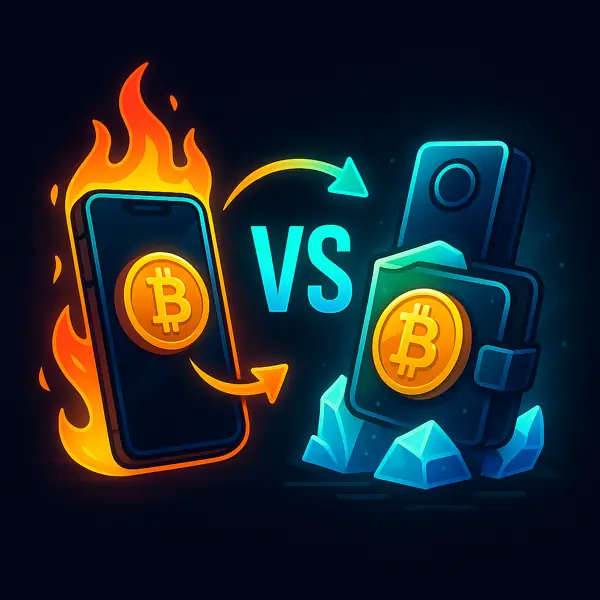If you’ve been around crypto Twitter or Telegram, you’ve probably heard the debate: hot wallets vs cold wallets. Some say hot wallets are too risky, others say cold wallets are overkill for beginners. So which should you actually use?
Let’s break it down in plain language, with examples, so you can decide what works for you.
What Is a Hot Wallet?
A hot wallet is a crypto wallet that stays connected to the internet. Think of it as your “checking account” in crypto.
Examples:
- MetaMask (browser + mobile app)
- Trust Wallet (multi-chain mobile wallet)
- Phantom (popular Solana wallet)
- Coinbase Wallet (not the exchange — the separate wallet app)
Pros of Hot Wallets:
- Free to use
- Easy to set up (download an app or extension)
- Instant access to Web3 apps, casinos, NFTs, and DeFi
- Perfect for daily use and small amounts
Cons of Hot Wallets:
- Always online → more exposed to hacks and phishing
- If your phone or computer gets compromised, so does your wallet
- Not ideal for storing large amounts long-term
What Is a Cold Wallet?
A cold wallet is a wallet that stays offline, disconnected from the internet. Think of it as your “crypto vault.”
Most cold wallets are hardware devices you plug into your computer only when signing transactions.
Examples:
- Ledger Nano X / Ledger Stax
- Trezor Model T
- SafePal (hardware option)
Pros of Cold Wallets:
- Extremely secure (offline by default)
- Immune to online hacks, phishing, and malware
- Perfect for long-term storage (HODLing BTC, ETH, stablecoins)
Cons of Cold Wallets:
- Costs money ($50–$300)
- Less convenient — not ideal for daily gambling, swapping, or memecoin trading
- If you lose the device + recovery phrase, funds are gone forever
When to Use Hot vs Cold
- Use a hot wallet for daily activities → gambling dApps, quick trades, NFT flips, sending crypto to friends.
- Use a cold wallet for savings → big stacks you don’t touch often.
Smart players and investors often use both:
- Hot wallet = daily spending & gambling money
- Cold wallet = savings account for long-term holds
Real-World Examples
- Gamblers: If you’re betting on Rollbit, Polymarket, or a Web3 casino, you’ll use a hot wallet like MetaMask or Phantom. Fast, easy, but only keep what you’re willing to risk.
- Investors: If you bought $5K worth of ETH or BTC for long-term, put it on a Ledger or Trezor. Think of it as locking gold in a safe.
- Mixed strategy: Many degens keep $200–$500 in a hot wallet for memes and gambling, while the real bag stays cold.
Risks Beginners Often Overlook
- Hot wallet danger: Fake MetaMask sites have drained thousands of wallets. Always double-check URLs.
- Cold wallet danger: Buy only from the official store. Hacked or resold Ledgers have led to millions lost.
- Backup mistakes: Both hot and cold wallets rely on seed phrases. Store them offline, never in screenshots or cloud notes.
Stats That Show the Divide
- Ledger has sold 6+ million hardware wallets worldwide.
- MetaMask reported 30+ million active monthly users in 2024.
- Chainalysis estimates that over 20% of Bitcoin in circulation is stored in cold wallets.
Hot wallets are the norm for daily use, but serious money gravitates to cold storage.
Which Should Beginners Use?
If you’re just starting:
- Begin with a hot wallet (MetaMask, Trust Wallet, or Phantom). It’s free, easy, and lets you explore Web3.
- Once you have more than a few hundred dollars or plan to HODL long-term, invest in a cold wallet.
Think of it like real life: you keep cash in your pocket for daily spending, but you store savings in a safe.
Final Word
Hot vs cold wallets isn’t an either/or choice. Beginners should start with a hot wallet for learning, gambling, and small trades. But once your bag grows, moving a chunk to cold storage is the smartest play.
The rule is simple:
- Hot wallets = convenience, short-term use, fun money.
- Cold wallets = security, long-term holdings, life-changing money.
Use both wisely, and you’ll have the best of both worlds — freedom to degen daily while protecting your future stack.
Wagmi 🚀


